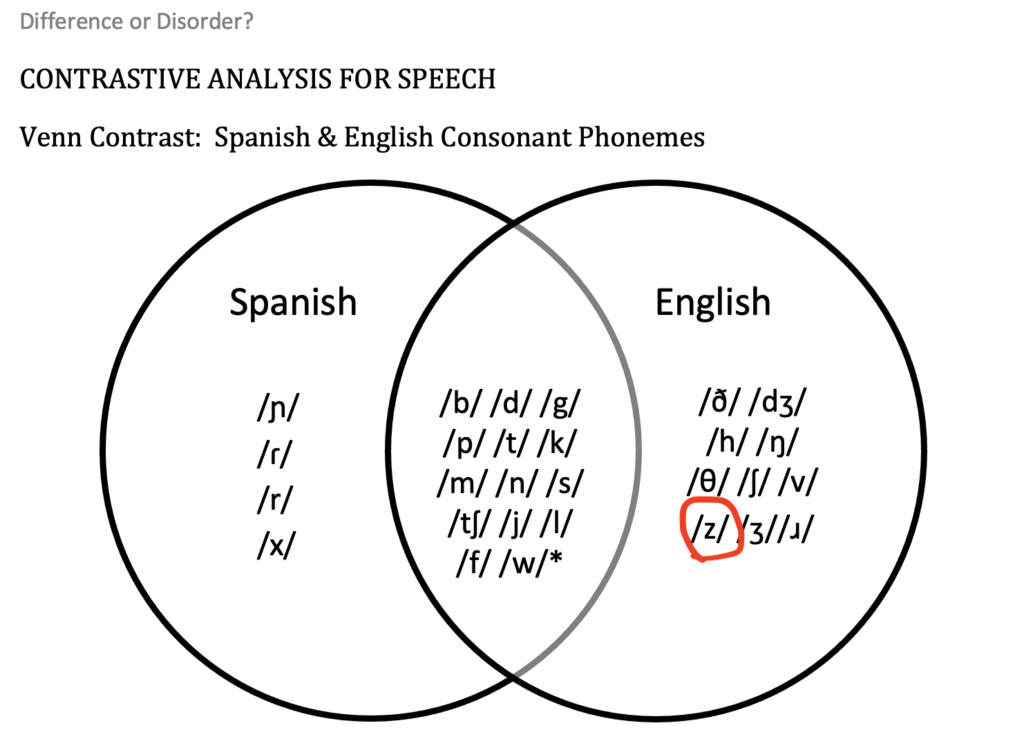When I do workshops for school districts that focus on conducting speech-language evaluations for bilingual students, one of the questions I get a lot is, “Is it okay to target cross-linguistic influence patterns (also called native language influence patterns) in intervention?” First and foremost, I’ll say that targeting native language influence patterns should not be a goal for your student. Nor should native language influence patterns be the reason the child is in speech therapy.
That said, if you are working with a child whose native language is Spanish on one of their appropriate goals, and in the course of intervention they produce “s” for “z” in their response, sure, go ahead and give them some guidance on that. Make their goals the focus but you can provide additional information as well.
Breaking down error patterns – Developmental patterns, cross-linguistic influence patterns, and atypical errors.
Let’s break this down. When we are conducting a bilingual speech-language evaluation we categorize “errors” that the child makes in one of the following ways:
- A typical developmental pattern
- A typical cross-linguistic influence pattern
- An atypical pattern
When we see a lot of atypical patterns or errors, that is indicative of a speech-language disorder. If we only see patterns that are typical for the child’s age (typical developmental patterns) or language background (typical cross-linguistic influence patterns), that child would NOT be diagnosed with a speech-language disorder and would therefore not be in speech therapy.
Thus, by default, any bilingual child who is accurately diagnosed with a speech-language disorder may be using a combination of all three categories in their speech and language production. So, we would write our goals based on the atypical patterns (or errors, really), and we can provide feedback on developmental patterns and cross-linguistic patterns during the course of treatment.
If you want to dive deeper into this process, here are some great resources.
- Book: Difference or Disorder: Understanding Speech and Language Patterns in Culturally and Linguistically Diverse Students (also available in ebook format)
- Course: Difference or Disorder: Speech Development in Bilingual Children
- Course: Difference or Disorder: Language Development in Bilingual Children
- The World Language Library
- MyLanguages
Examples of Cross-Linguistic Influence in Speech Intervention and Language Intervention
Let’s look at a couple of examples. We’ll start with an example from the speech side and then we’ll look at a language-based example.
Example of Cross-Linguistic Influence Used During Speech Intervention
In working with Kevin, who speaks Spanish as his first language and English as his second language, we are targeting the final consonants. Kevin often omits final consonants. We work with Kevin in both English and Spanish. On this particular day, Kevin and his class had just returned from a field trip to the zoo and we asked Kevin to tell us about his field trip. He said, “We went to the soo and saw sebra and sea(ls).” In addition to omitting final sounds, Kevin is substituting [s] for [z], which is a common Spanish-influenced English pattern.
My response to Kevin is, “Oh, that is fantastic, Kevin. Let’s think about your sounds at the end of the words. You saw zebras and seals. Let’s practice these words. Zebras. Seals. Do you see how when I said Zebras my voice was on for the first sound Z. That’s how Z is pronounced when we are using English. You used the Spanish sound for the letter Z, which is [s]. Now, let’s focus on that [z] sound at the end of the word Zebras.”
If he produces [s] at the end of the word instead of [z], I would consider that a win because our goal is final sounds and producing [s] for [z] is a common Spanish-influenced English pattern.

So, to sum up our speech example, focus on the child’s goals, model correct productions of cross-linguistic influence patterns where appropriate and highlight the differences in their two languages in those instances. If they continue to use the native language influence pattern, we won’t worry about that or count it against them.
Example of Cross-Linguistic Influence Used During Language Intervention
Now, let’s look at a language goal.
Kevin is also receiving intervention to address the following language goals:
- Kevin will talk about past events using past tense verbs in English and Spanish.
- Kevin will use complex sentences when telling a story or sharing about his activities.
On this particular day we are working on both of these goals simultaneously in English. Kevin was asked to tell us about what he did in the morning and tell why he was late for school. He said, “This morning I was eating breakfast and I spilled salsa red on my shirt and then I had to clean it.”

My response to Kevin is, “Wow, Kevin, excellent job marking the past tense when you said “spilled.” Remember that one of the ways we can make a complex sentence is using the word “because” to connect your ideas. So you might say, “I was late for school because I spilled red salsa on my shirt and I had to clean it. Notice that in Spanish you say, “salsa roja” but in English you say, “red salsa.” The color goes before the thing in English but after the thing in Spanish.
Focus on the goal first and highlight the crosslinguistic influence patterns second.
Doesn’t the ESL Teacher Teach about Cross-Linguistic Influences?
Does this make me the ESL teacher? No, it really doesn’t. Yes, those are things that are targeted by the ESL teacher, whose job it is to highlight the differences between the languages. The difference here is that I am not targeting those patterns to work on. I noticed that he used a cross-linguistic pattern and I brought it to his attention but it wasn’t the focus of our session and it is not a goal in his educational plan.


